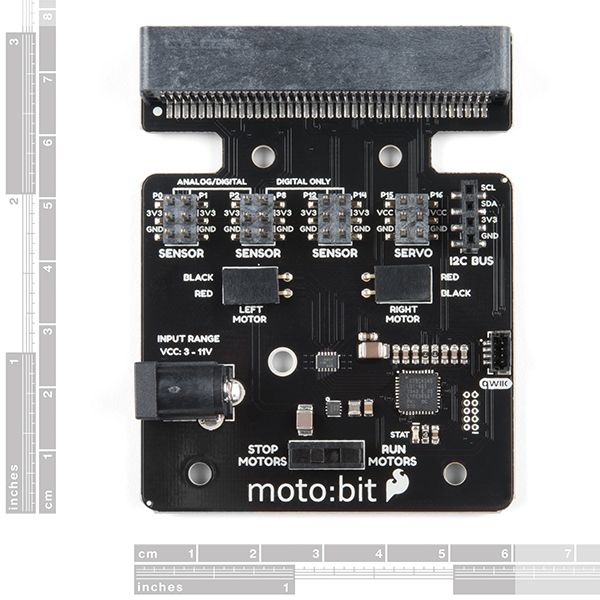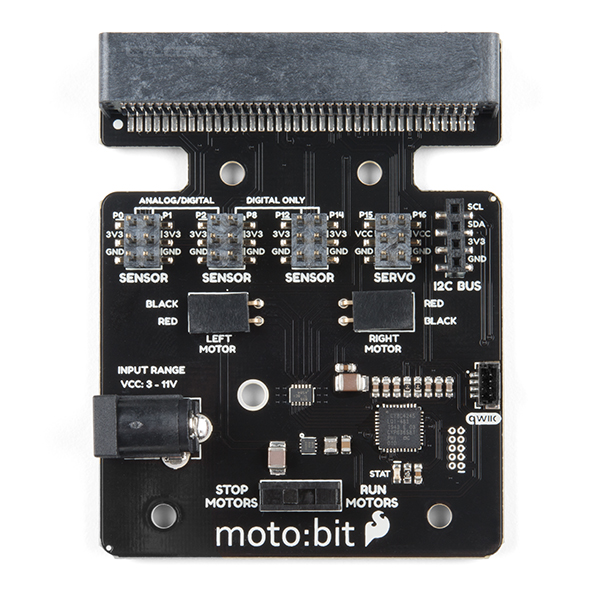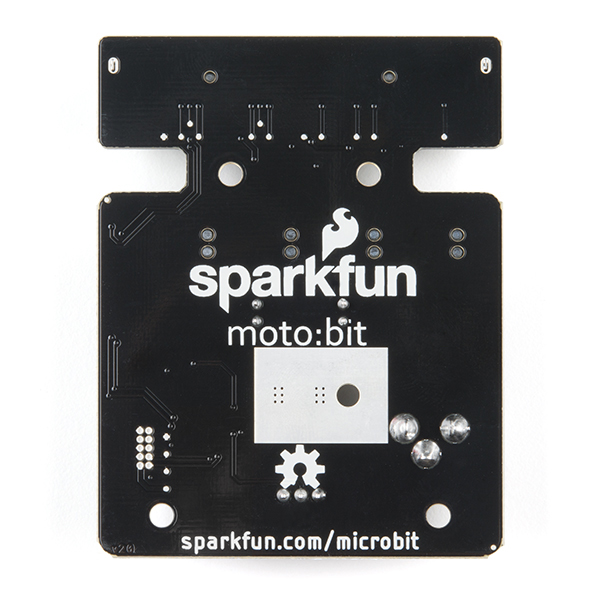SparkFun moto:bit - micro:bit Carrier Board (Qwiic)
The SparkFun moto:bit is a fully loaded "carrier" board for the micro:bit that, when combined with the micro:bit, provides you with a fully functional robotics platform. The moto:bit offers a simple, beginner-friendly robotics controller capable of operating a basic robotics chassis. Onboard each moto:bit are multiple I/O pins, as well as a vertical Qwiic connector, capable of hooking up servos, sensors and other circuits. At the flip of the switch you can get your micro:bit moving!
The moto:bit connects to the micro:bit via an updated SMD, edge connector at the top of the board, making setup easy. This creates a handy way to swap out micro:bits for programming, while still providing reliable connections to all of the different pins on the micro:bit. We have also included a basic barrel jack on the moto:bit that is capable of providing power to anything you connect to the carrier board.
The micro:bit is a pocket-sized computer that lets you get creative with digital technology. Between the micro:bit and our shield-like bit boards you can do almost anything while coding, customizing and controlling your micro:bit from almost anywhere! You can use your micro:bit for all sorts of unique creations, from robots to musical instruments and more. At half the size of a credit card, this versatile board has vast potential!
Note: The SparkFun moto:bit does NOT include a micro:bit board. The micro:bit will need to be purchased separately.
- More reliable Edge connector for easy use with the micro:bit
- Full H-Bridge for control of two motors
- Control servo motors
- Vertical Qwiic Connector
- I2C port for extending functionality
- Power and battery management onboard for the micro:bit
SparkFun moto:bit - micro:bit Carrier Board (Qwiic) Product Help and Resources
Getting Started with the micro:bit
September 2, 2021
The BBC micro:bit is a compact, powerful programming tool that requires no software installation. Read on to learn how to use it YOUR way!
micro:bot Kit Experiment Guide
February 20, 2020
Get started with the moto:bit, a carrier board for the micro:bit that allows you to control motors, and create your own robot using this experiment guide for the micro:bot kit.
Wireless Remote Control with micro:bit
January 21, 2019
In this tutorial, we will utilize the MakeCode radio blocks to have the one micro:bit transmit a signal to a receiving micro:bit on the same channel. Eventually, we will control a micro:bot wirelessly using parts from the arcade:kit!
Core Skill: Robotics
This skill concerns mechanical and robotics knowledge. You may need to know how mechanical parts interact, how motors work, or how to use motor drivers and controllers.
Skill Level: Rookie - You will be required to know some basics about motors, basic motor drivers and how simple robotic motion can be accomplished.
See all skill levels
Core Skill: Programming
If a board needs code or communicates somehow, you're going to need to know how to program or interface with it. The programming skill is all about communication and code.
Skill Level: Rookie - You will need a better fundamental understand of what code is, and how it works. You will be using beginner-level software and development tools like Arduino. You will be dealing directly with code, but numerous examples and libraries are available. Sensors or shields will communicate with serial or TTL.
See all skill levels
Core Skill: Electrical Prototyping
If it requires power, you need to know how much, what all the pins do, and how to hook it up. You may need to reference datasheets, schematics, and know the ins and outs of electronics.
Skill Level: Rookie - You may be required to know a bit more about the component, such as orientation, or how to hook it up, in addition to power requirements. You will need to understand polarized components.
See all skill levels
Comments
Looking for answers to technical questions?
We welcome your comments and suggestions below. However, if you are looking for solutions to technical questions please see our Technical Assistance page.
Customer Reviews
No reviews yet.





If you'd like to use this module with the latest micro:bit Python Editor, I've written a driver module for it. It's pretty simple, and based on the API of the PXT module written by Sparkfun.
https://gist.github.com/stonehippo/6b9f2f0d4cbec54f61ddb91adcd0b289
I've used this for awhile and unfortunately, I'm a bit disappointed in it. The i2c, Qwiic, and motor connectors are all fragile and are not fastened to the board very well. This means they bend up or easily come off (like the Qwiic connector did).
Also the decision to make the whole thing lie flat means that it's pretty long, about 4 1/2" with the micro:bit plugged in. So it takes up a lot of space on a small robot and hangs over the edge.
At this point my board has stopped working well...I can't get i2c devices to respond and the motors won't run correctly in one direction, using the code that worked in the past. I have to suggest you look at the other micro:bit motor boards on the market.
Does anyone have a Fritzing file for this board?